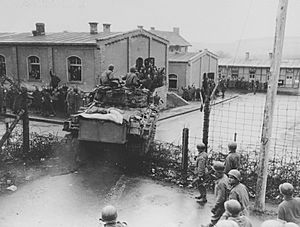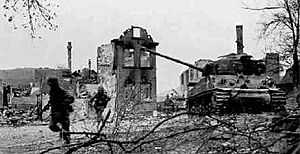Task Force Baum facts for kids
Quick facts for kids Raid on Hammelberg |
|||||||
|---|---|---|---|---|---|---|---|
| Part of the Western Allied invasion of Germany in the Western Front of the European theatre of World War II | |||||||
 An M4 medium tank of the 47th Tank Bn., 14th Armored Division crashes into the prison compound at Oflag XIII-B, 6 April 1945 - two weeks after the failed Task Force Baum raid. |
|||||||
|
|||||||
| Belligerents | |||||||
| Commanders and leaders | |||||||
| Units involved | |||||||
|
Elements of 4th Armored Division
|
Elements of 251st Infantry Division
|
||||||
| Strength | |||||||
| 11 officers and 303 men 16 tanks, 28 half-tracks, and 13 other vehicles. |
Unknown | ||||||
| Casualties and losses | |||||||
| 32 killed 256 wounded, missing or captured All tanks and vehicles destroyed or captured |
Unknown | ||||||
Task Force Baum, also known as the Hammelburg raid, was a secret mission during World War II. It was ordered by U.S. Army General George S. Patton in March 1945. The mission was led by Captain Abraham Baum.
The goal was to travel 50 miles (80 km) behind German lines. The task force was supposed to free POWs (Prisoners of War) held at a camp called Oflag XIII-B. This camp was located near Hammelburg, Germany.
Many people believe the real reason for the mission was to rescue Patton's son-in-law, John K. Waters. He had been captured in 1943. The mission did not go well at all. Out of about 300 men, 32 were killed. Only 35 made it back to Allied territory. All 57 tanks and other vehicles were lost. Most of the remaining soldiers were captured.
Contents
What Was the Hammelburg Camp Like?
A Prisoner of War Camp
Camp Hammelburg was about 1.8 miles (3 km) south of the town of Hammelburg. It was first used for military training before World War I and World War II. During World War II, it became two separate POW camps.
Stalag XIII-C held Allied enlisted men (regular soldiers). Oflag XIII-B held Allied officers (commanders). At first, Oflag XIII-B only held Serb officers. Later, it was split into sections for American officers and Serb officers.
In January 1945, many American POWs arrived from the Battle of the Bulge. This battle had started in December of the previous year. The American part of the camp was quickly made ready for them.
Long March to Hammelburg
As Soviet forces moved west into Germany in late 1944, a POW camp called Oflag 64 in Poland was emptied. On January 21, 1945, 1,290 POWs began a long march. They walked west into Germany and then south toward Hammelburg.
Among these prisoners was Lt. Col. John K. Waters, General Patton's son-in-law. He had been captured in Tunisia in February 1943. The prisoners traveled 340 miles (547 km), mostly on foot, over seven weeks. They finally reached Oflag XIII-B on March 9.
By the time these men arrived, the officer camp had over 1,400 prisoners. The enlisted men's camp had even more, with an estimated 5,000 men.
Life in the Camp
Conditions at the camp were very hard for everyone. The winter of 1944 was one of the coldest ever. The buildings were very crowded. Each small room, meant for 40 prisoners, had bunk beds.
Heat was scarce. Only a small amount of coal was given for furnaces every three days. Even with some men finding wood, it was not enough. The average temperature in the rooms was around 20 °F (−7 °C).
Food was also very hard to find. Prisoners were given about 1,700 calories a day at first. This is much less than the 2,000 calories recommended for men doing no work. As supplies ran low, this was cut even more, to about 1,070 calories daily.
Many men lost a lot of weight, sometimes over 50 pounds (23 kilograms). Their muscles became weak from lack of food and movement. Poor hygiene also led to illnesses like dysentery, making the men even weaker.

Getting Ready for the Mission
General Patton gave the mission to a part of the U.S. 4th Armored Division. This group was called Combat Command B (CCB). Its commander, Lt. Col. Creighton Abrams, wanted to use more soldiers and vehicles. However, Patton decided to send a smaller force.
The task force included one company of medium tanks, a platoon of light tanks, and one company of armored infantry. A company is a military unit, usually around 100-250 soldiers. Captain Abraham Baum was chosen to lead the mission. The task force set out on the evening of March 26.
In total, the force had 11 officers and 303 men. They had 16 tanks, 28 half-tracks (vehicles with wheels in front and tracks in back), and 13 other vehicles.
The Mission Begins
Journey to Hammelburg
On the evening of March 26, the task force reached Aschaffenburg. They faced heavy German fire, which damaged several vehicles. One of their Sherman tanks was disabled. It took until the next morning to get past the German lines.
A big problem for the mission was the lack of maps. They only had 15 maps for 57 vehicles. They also did not know the exact location of the camp. They had to ask local people for directions along the way. This slowed them down a lot. It also made them face more enemy fire than expected.
A German plane spotted the column as it got closer to the camp. This plane helped the Germans organize their defense against the task force. Some German "Hetzers" (small tank destroyers) were sent to help.
Reaching the Camp
By the afternoon of March 27, the tanks arrived near the camp. Some of the German guards fought back, but many ran away or surrendered. The Serb section of the camp was hit by American fire as the tanks approached. This was probably because the Serb prisoners wore gray uniforms, which looked like German uniforms to the Americans.
General Gunther von Goeckel, the camp commander, asked John K. Waters to help arrange a truce. Waters agreed to try and tell the Americans about the mistake. As Waters and some men, including a German officer, approached the American column, an uninformed German soldier shot Waters. He was taken back to the camp and treated by Serb doctors.
About half of Baum's force made it to Hammelburg ready to fight. Thousands of cheering prisoners greeted them. Baum quickly realized there were far more prisoners than the 300 officers they expected to free. He figured they could only take about 200 men back with their remaining vehicles.
They decided that only field-grade officers (higher-ranking officers) could ride back. Other prisoners who wanted to could try to march with the column or walk on their own to American lines. These lines were about 50 miles (80 km) to the west. Most of the POWs were too weak to walk and chose to stay behind. Waters, who was injured, also had to stay in the camp.
The Difficult Retreat
The task force left the camp at 8 PM that night to go back across German lines. More problems appeared. There was no moon that night, so they had to use artificial light for navigation. This light could be easily seen by the increasing number of German troops.
Only one reconnaissance jeep could scout ahead to find an escape route. Sometimes, the tanks had to be turned off completely to avoid being seen by the Germans surrounding them.
Near Höllrich, in the dark, Task Force Baum ran into a German ambush. Veteran German soldiers from a combat school had set it up. The first tank was hit by a German panzerfaust (a type of rocket launcher). It was abandoned and captured. Then, a German soldier drove this captured tank and used its radio to trick more American tanks into the ambush. Four American Sherman tanks were destroyed.
The remaining parts of the task force gathered again near Hill 427 in the early morning. They did not have enough fuel to get back across the line. They waited for daylight to travel with better visibility. Colonel Goode, a senior American officer at the camp, knew most of the men could not make it on their own. He advised the wounded to go back to Oflag. Colonel Goode himself decided to return to the camp under a white flag so he would not slow down the others.
Baum ordered the force to move out shortly after dawn on March 28. As they started, they immediately came under fire from all directions. Germans had surrounded the hill during the night. They opened fire at the first sign of movement. Knowing they could not fight off the attack, Baum told every man to save himself. The battle lasted only minutes. Survivors who had not escaped into the woods were captured. Baum managed to escape into the nearby woods with two soldiers. Many American POWs from the camp also escaped into the woods. Baum was Jewish and threw away his dog tags, fearing he would be killed if identified.
What Happened Next?
As the Soviets moved from the east, the Americans advanced into Germany days after the task force. The Germans moved POWs further away from the fighting. Those who could move were put into unmarked boxcars and sent by train to Nuremberg. From there, they went to other prisoner camps away from the front lines. The remaining men were left behind at Hammelburg.
Baum was wounded while trying to get back to Allied lines. He was captured by the Volkssturm (German home guard). He joined Waters in the Serbian hospital at the Hammelburg camp. The camp was finally freed by the 14th Armored Division on April 6. This was just nine days after Task Force Baum's failed mission. It was ironic that the failure of the task force helped Waters get free sooner. If he had not been shot, he would have been marched to another camp deeper in Germany with the other POWs.
It is said that Patton offered Baum a Medal of Honor if the mission succeeded. A Medal of Honor requires an investigation, which Patton likely wanted to avoid. So, Baum received a Distinguished Service Cross instead. Patton personally gave it to him.
People still argue whether Patton knew his son-in-law was at the camp. Many at the camp and Abraham Baum believed he did. Patton sent an aide, Major Alexander Stiller, with the task force. His purpose was supposedly to identify Waters so he could be taken back. Patton's publicly available diaries say he did not know until after the task force arrived. However, a letter he wrote to his wife just after the task force left suggests otherwise: "I sent a column to a place forty miles east of where John [Waters] and some 900 prisoners are said to be. I have been nervous as a cat… as everyone but me thought it too great a risk…. If I lose that column, it will possibly be a new incident. But I won’t lose it."
General Eisenhower was very angry and criticized Patton for the incident. Patton admitted the mission failed. But he defended his actions, saying he feared the retreating Germans might kill the prisoners. Events like the Malmedy massacre and the Stalag Luft III murders showed that Germans had killed POWs before. Patton said his only mistake was sending a force that was too small. He believed he should have sent a full combat command to take Hammelburg.
Captain Abe Baum was born in the Bronx, New York, on March 29, 1921. He passed away at age 91 on March 3, 2013. Baum had fought in Normandy and was a tough, experienced officer. He was surprised when Patton gave him the orders for the raid. He later wondered, "What the hell am I doing here?"
See also
- Oflag XIII-B
- Stalag 17


